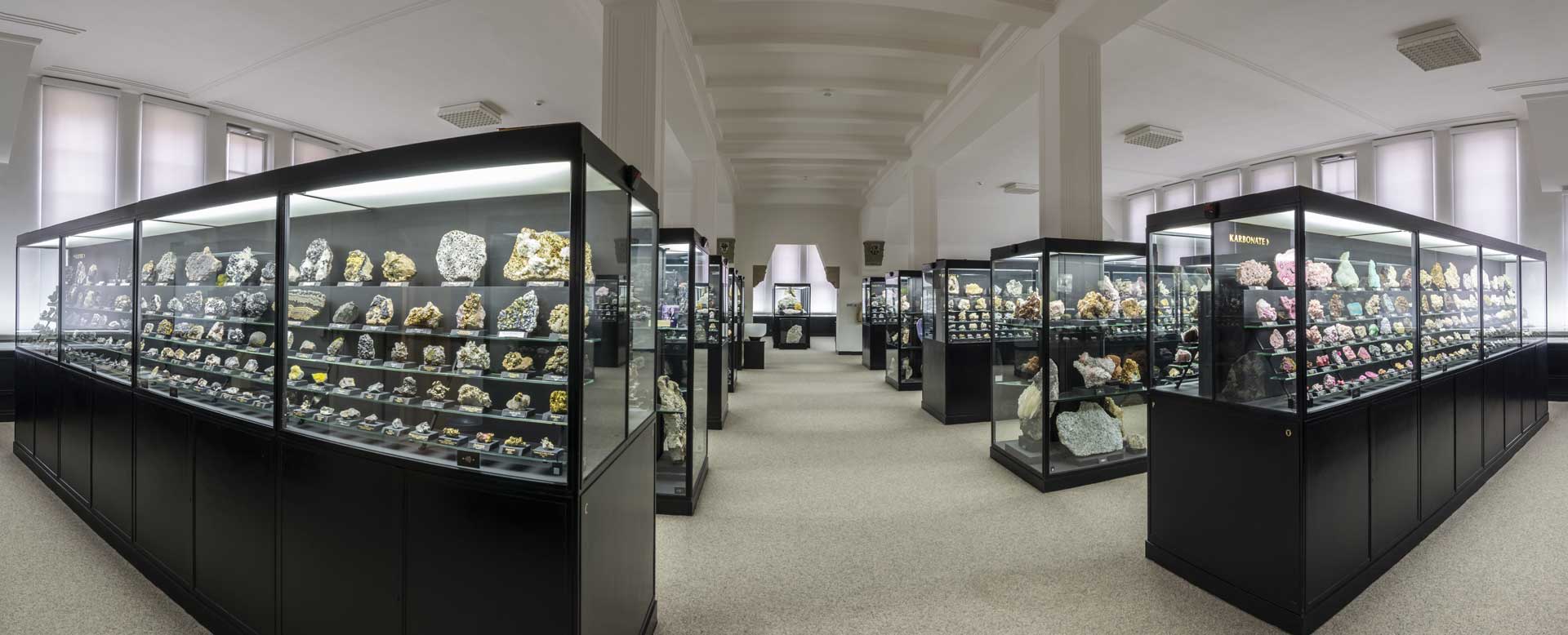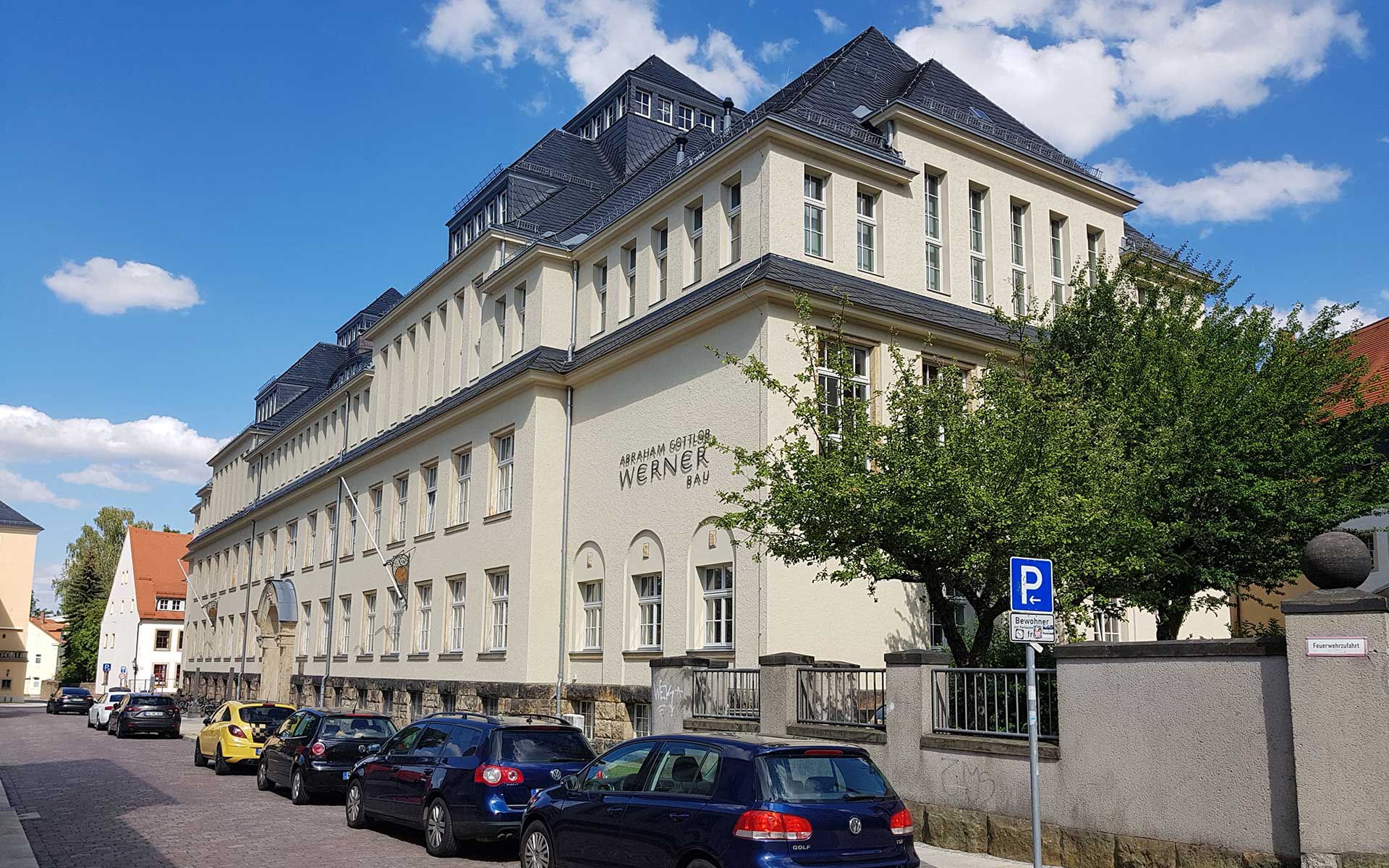Mineralogical Collections of the TU Bergakademie Freiberg (Mining Academy)
Germany

View into the exhibition hall of the Mineralogical Collection. Photo: Hartmut Meyer.
Housing institution
Technische Universität Bergakademie Freiberg
Location
Brennhausgasse 14, D-09599 Freiberg
UTM: 33U (E)383560 (N)5642325
Homepage
View into the exhibition hall of the Mineralogical Collection. Photo: Hartmut Meyer.
The Mineralogical Collections of the oldest Mining Academy are among the largest and most beautiful university collections in the world.
- Geo-collection description
Freiberg, the classic region of silver mining and cradle of mineralogy, is home to one of the largest, oldest and most beautiful mineralogical collections in the world. Around 9,000 minerals, gemstones, meteorites and rocks are exhibited on an area of almost 1,000 m2 of the Abraham-Gottlob-Werner-Building [1]. The exhibitions are systematically structured and serve primarily to educate students. The best specimens from the Saxon Ore Mountains were also complemented by visually attractive specimens from all over the world, so that the collection is also of interest to the general public. The beginnings of the collection go back to 1765, when the oldest Mining Academy of the world was founded. The most important historical basis of our current mineralogical collections are the extensive private geoscientific collections of Abraham Gottlob Werner (1749-1817), which were purchased by the Mining Academy in 1814. After Werner’s death, famous scientists completed and developed the collections. These includes Friederich Mohs (1773-1839), August Breithaupt (1791-1873), Albin Weisbach (1833-1901), Bernhard von Cotta (1808-1879) and Hans Jürgen Rösler (1920-2009) [2]. The Mineralogical Collections are part of the Geoscientific Collections, which are a central operating unit of the Faculty of Geosciences, Geotechnics and Mining at the Technische Universität Bergakademie Freiberg.
- Geo-collection value
The collection focuses on the systematics of the respective scientific fields (mineralogy, petrology and economic geology) as well as deposits and mineral sites in Saxony. This makes the exhibitions ideal for training both our students and schools as part of the curriculum. Tour operators use our collections and offer educational tours. All objects in the collections have been classified as national and international cultural assets. The most important historical suite is the collection of Abraham Gottlob Werner with his first descriptions and first namings and the originals of his book “On the external characteristics of fossils (1774)”. The many first descriptions and designations by Breithaupt and Weisbach from the 19th century and the originals by Cotta, Stelzner, Schumacher, Kolbeck and many other famous geoscientists are also of great scientific value. The 102 type specimens are wellpublished [5]. The stored samples from a large number of student theses, dissertations, research projects and field trips are also of great scientific importance. In addition to the geological samples, there is also a historical suite of well over 1000 crystal models made of wood, porcelain and brass from the 18th and 19th centuries, which goes back to Werner and was expanded by Weisbach [6].
- Reference
- Massanek, A.; Rank, K. Heide, G.: The mineralogical collections of the TU Bergakademie Freiberg. – In: Kongsberg Mineral Symposium, Norsk Bergverksmuseum, Skrift nr. 50 (2013) 5-21
- Massanek, A.: The Mineralogical Collection of the Freiberg Mining Academy. – In: The Mineralogical Record, 46(2015)3, 385-391
- https://webapp.senckenberg.de/aquila-freiberg/search?
- https://sachsen.digital/sammlungen/oryktognostische-sammlung-von-abraham-gottlobwerner
- http://www.typmineral.uni-hamburg.de/en/collect/index.html#de_frei_01
- Kjellmann, J., Heide, B. & Heide, G.: On the Historical Crystal Model Sets in the Mineral Collections of Abraham Gottlob Werner of the TU Bergakademie Freiberg. – In: Freiberger Forschungshefte, D250 (2020)149-179

